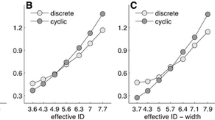Abstract.
Based on the kinematics of goal-directed aiming movements in a reciprocal Fitts' task, a minimal limit cycle model is proposed that is capable of producing the behavior observed at levels of task difficulty ranging from 3 to 7. From graphical and statistical analyses of the phase planes, Hooke's planes and velocity profiles, we concluded that the minimal terms to be included in the model were (i) a nonlinear damping in the form of a self-sustaining, velocity-driven Rayleigh oscillator and (ii) a nonlinear stiffness in the form of a softening spring Duffing term. The model reproduced the kinematic patterns experimentally observed in rhythmical precision aiming, accounting for 95% of the variance. The coefficients in the model changed in a systematic way when distance and precision constraints were varied, and the meaning of these changes is discussed in the framework of the dynamical patterns approach.
Similar content being viewed by others
Author information
Authors and Affiliations
Additional information
Received: 20 April 1998 / Accepted in revised form: 24 November 1998
Rights and permissions
About this article
Cite this article
Mottet, D., Bootsma, R. The dynamics of goal-directed rhythmical aiming. Biol Cybern 80, 235–245 (1999). https://doi.org/10.1007/s004220050521
Issue Date:
DOI: https://doi.org/10.1007/s004220050521




